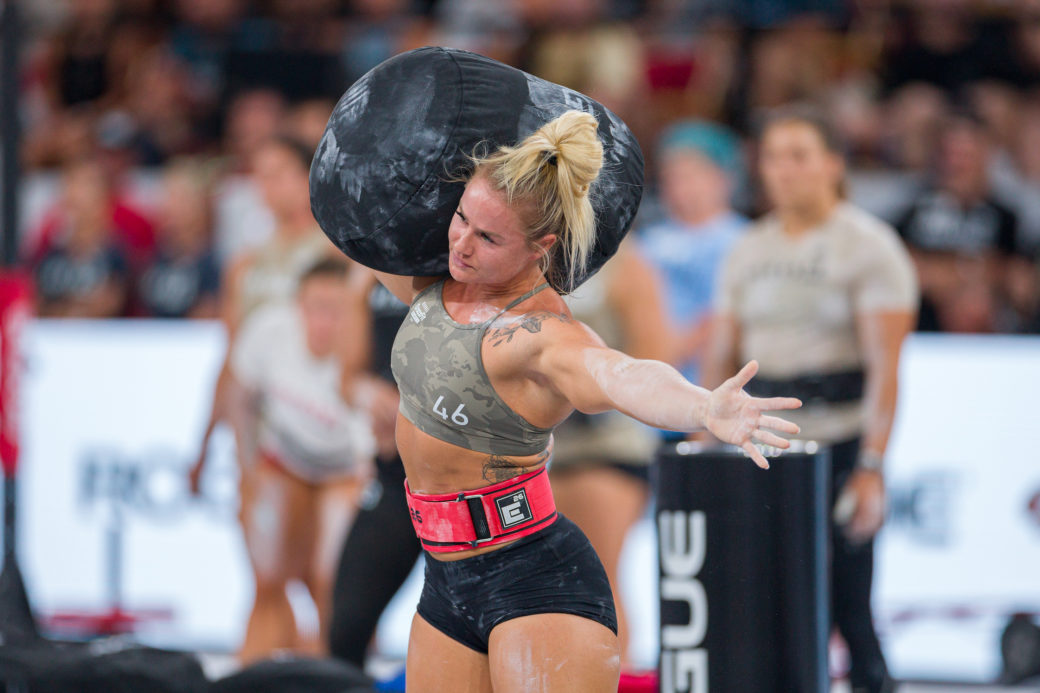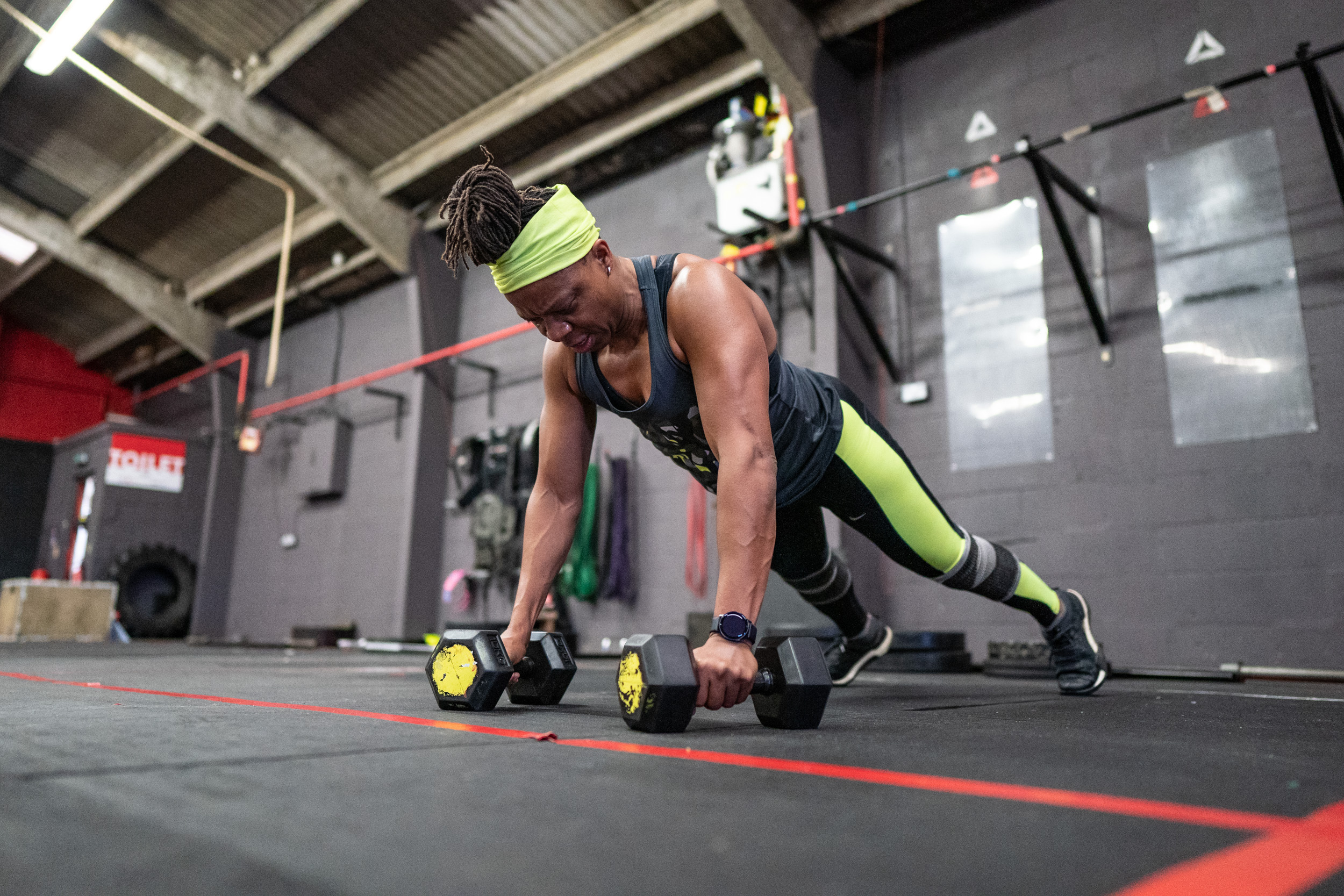“She literally has man muscles.”
The above is a comment left on a YouTube video featuring female CrossFit Games athletes. Women completing feats of physical prowess so grand and varied that their ability to accomplish them can mean only one thing: They’re really freaking fit.
But the last time I checked, “fit” wasn’t synonymous with “masculine.”*
“Not only does CrossFit make people fit, but arguably we make them fitter faster and more safely than any other program out there. Our results are universal, predictable, and repeatable. Our methodology works for everyone, can be scaled for anyone, and the results accrue over the long term.”

Dani Speegle won Sandbag Ladder at the 2022 NOBULL CrossFit Games with a 250-lb lift.
The CrossFit methodology is rooted in science. We say someone is fit not based on how they look, but based on performance that is measurable, observable, and repeatable.
“There are 10 recognized general physical skills,” writes CrossFit Founder Greg Glassman. “They are cardiovascular/respiratory endurance, stamina, strength, flexibility, power, speed, coordination, agility, balance and accuracy. You are as fit as you are competent in each of these 10 skills.”
Standards of beauty (which, historically, is how society has gauged femininity) on the other hand, are based on societal constructs — and not even very long-standing ones.
“Thin” as the standard for the feminine ideal only really came about in the 19th century.
Consider the Venus de Milo, likely created by Alexandros of Antioch in the second century BC. Historians agree she was likely created to represent Aphrodite — the Greek goddess of love and beauty (Roman counterpart Venus) — as well as the ideal feminine body of the time. And she’s got abs.
That feminine ideal continued to evolve, favoring plumper figures at times and slimmer ones at others. But it wasn’t until the 1920s and the rise of the flapper era that thinness became prized above all else in women, inciting an epidemic of eating disorders.
I write all that merely to point out that the feminine ideal has A, never remained constant, and B, only ever been a matter of opinion.

The natural consequence of CrossFit training is increased work capacity across broad time and modal domains.
“The CrossFit practitioner’s athletic development comes from performing constantly varied functional movements executed at high intensity in combination with sound nutrition. Each of these elements is critical for optimizing fitness and health.”
So what about science? Our commenter argues that a female CrossFit Games athlete has “man muscles.” My first instinct was to ask them to tell me the difference between a male brachioradialis and a female one, but then I wondered: “Is there a difference between male and female muscle tissue?”
Literature suggests that the main difference between male and female musculature is volume, with women having a higher percentage of body fat and a lesser percentage of muscle mass per pound than men. Women are also purported to have fewer fast-twitch skeletal muscle fibers — those that provide lots of power but fatigue quickly — than men. But a 2019 study comparing elite male and female weightlifters — and finding that some of the women had more fast-twitch muscle fibers than the men — has challenged that theory.
“These findings suggest athlete caliber, training experience and body mass determine the percentage of fast twitch fiber more than gender,” writes one of the study’s authors, James Bagley. “It used to be thought that fiber type was what you were born with, but we show that’s not the case — training has a huge influence.”
So if it even exists, the difference between male and female muscle tissue is inconsequential; therefore, I can only assume “man muscles” refers to volume and definition. A woman shouldn’t have too much muscle mass, and what she has definitely shouldn’t be visible.
It’s the “shouldn’t” that worries me.
One “shouldn’t” drink bleach, as the natural consequence of that action is stomach erosion. But the natural consequence of CrossFit training?
“Increased work capacity across broad time and modal domains,” writes Nicole Carroll, CrossFit’s General Manager of Education and Training. “Pursuing this goal is pursuing fitness, and aiming to maintain your work capacity over your lifetime is pursuing health.”

Fitness across one’s lifetime is health.
“What CrossFit achieves: increased work capacity across broad time and modal domains. Pursuing this goal is pursuing fitness, and aiming to maintain your work capacity over your lifetime is pursuing health.”
If you eat meat and vegetables, nuts and seeds, some fruit, little starch, and no added sugar in quantities that support exercise but not body fat; practice and train major lifts; and mix these elements in as many ways as creativity will allow five or six days per week, you’ll lose excess body fat and you’ll build muscle. Your work capacity will increase. This is true regardless of your sex.
Health, CrossFit argues, is a person’s work capacity over their lifetime. Therefore, the more work capacity you have and the longer you can sustain it, the healthier you are. This is also true regardless of sex.
If a training and nutrition regimen increases one’s health, prolonging one’s natural lifespan and quality of life — dare I declare this a universal positive outcome? — we must assume that the accompanying adaptations are also positive. The healthiest version of a biological male? He can move large loads long distances quickly, and can do so into old age. The healthiest version of a biological female? She can move large loads long distances quickly, and can do so into old age. Both will have the corresponding musculature to show for it.
Put another way, the women of the CrossFit Games, in all their chiseled glory, can be nothing but a natural expression of biological femininity — one expression among many.
If you don’t like it; if you think women shouldn’t be muscular, I challenge you to ask yourself why you’d prefer women to limit their capacities — and therefore, their health.
*“Gender” refers to internal and social identity; “sex” refers to biological characteristics. For the sake of simplicity, any references made here to “male,” “female,” “men,” “women,” or variations thereof are intended as references to sex.